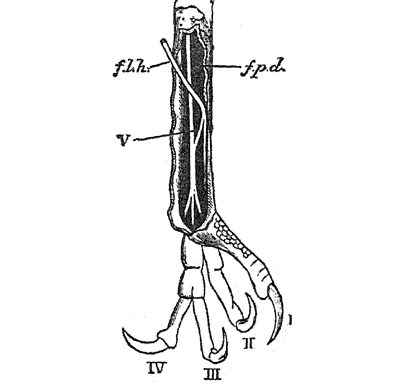Pages 01 02 03 04 05 06 07 08 09 10 11 12 13 14 15 16 17 18 19 20 21 22 23 24 25 26 27 28 29 30 31 32 33 34 35 | |||
| Page 2 | prev page next page | ||
 Fig. 1 - Psarisomus dalhousiae and nest (Hodgson’s drawing) Order II. EURYLAEMI Palate aegithognathous. The deep plantar tendons differ from those of the Passeres in the flexor longus hallucis being connected by a vinculum with the flexor profundus digitorum, as shown in the accompanying figure (fig. 2). Syrinx mesomyodian and oligomyodian as in Pittidae. The sternum as in the Passeres has but one notch on each side of the hinder border also, but the manubrium sterni is unforked, as in most non-passerine birds. Oil gland present but nude. The relations of the Eurylaemi or Broadbills to other birds have long been in dispute. At one time members of the present group were referred to the neighborhood of Coracias. But, chiefly through the researches of Blanchard, Garrod, and Forbes, the close alliance between the Eurylaemi and Passerine birds has now been ascertained, and the only question remaining is whether the Broadbills should be included in the Passerine group as a distinct section, or whether they should form a suborder or order apart. The latter is the view advocated by Seebohm and Sharpe, and accepted, as a provisional arrangement, in the present work. There is but a single family, confined to the Oriental region.
Bill normally broad and flat as in some Muscicapidae. Feet adapted for perching; hind toe large, anterior toes joined at the base, the outer and middle toes (third and
fourth) having only the last phalanx free (fig. 2). Tarsi reticulated behind, transversely scutellated in front, the scutellation often ill-marked and in some genera
disappearing entirely on the inner anterior side of the tarsus. Tail generally rounded, often graduated.
|
| ||
|
The Broadbills are forest birds living generally in small flocks amongst high trees, and feeding as a rule on insects. They are often remarkably tame, some of them being, it is said, so unwilling to move that several out of the same flock may be shot one after the other, without the survivors being alarmed. They build large round nests of grass and fibres, somewhat resembling those of the Nectariniidae, suspended from a fine twig and with an opening at the side (fig. 1). The eggs as a rule are white or cream-colored, much speckled, especially towards the larger end, but occasionally they are spotless. The genera in this family are more distinct than is usually the case amongst Birds, each being distinguished by a peculiar type of coloration. No species occur in the peninsula of India, nor in Ceylon, but the range of the family extends from the western Himalayas to the Philippines and Borneo, the majority inhabiting the Malay peninsula.
a. Nostrils exposed Genus EURYLAEMUS, Horsfield, 1821 Bill large, broad and flat, culmen very blunt, sides of upper mandible overhanging and convex near the gape. Nostrils rounded, exposed, at base of bill. Wings and tail rounded, the wing much longer than the tail. Rictal bristles present but small. Scutellation of tarsus in front almost obsolete, inside of tarsus covered with an undivided lamina. Upper plumage chiefly black and yellow; lower plumage wholly vinaceous red. Two species are known, ranging from Tenasserim to the Malay archipelago. Key to the Species
| |||
| prev page :: next page | |||
 birding.in
birding.in
| Birds | Bird Diagram | Ornithology | Indian Sites | Bird Watching | Migration | North India | Birds of India | Haryana |
All rights reserved. Copyright © 2005-2013 Birds and birding in India. Disclaimer
website: Free Java Guide & Tutorials
